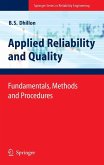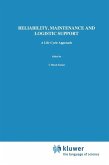27 Required function (mission profile) . Set up the reliability block diagram FMEA where (RBD), by performing a redundancy appears Eliminate reliability weaknesses . Determine the component stresses . component/material selection . Compute the failure rate Ai of each . derating component . screening . Compute R(t) at the assembly level . redundancy . Check the fulfillment of reliability design rules . Perform a preliminary design review no yes Go to the next assembly or to the next integration level Figure 2. 1 Reliability analysis procedure at assembly level Taking account of the above considerations, Fig. 2. 1 shows the reliability analysis procedure used in practical applications at assembly level. The proce dure of Fig. 2. 1 is based on the part stress method discussed in Section 2. 2. 4 (see Section 2. 2. 7 for the part count method). Also included are a failure modes and effect analysis (FMEA/FMECA), to check the validity of the assumed failure modes, and a verification of the adherence to design guidelines for relia bility in a preliminary design review (Section 5. 1, Appendices A3. 3. 5 & A4). Verification of the assumed failure modes is mandatory where redundancy appears, in particular because of the series element in the reliability block diagram (see for instance Example 2. 6, Sections 2. 3. 6 for elements with more than one failure mode & 6. 8. 7 for common cause failures, and Figs. 2. 8- 2. 9 & 6. 17- 6.
Dieser Download kann aus rechtlichen Gründen nur mit Rechnungsadresse in A, B, BG, CY, CZ, D, DK, EW, E, FIN, F, GR, HR, H, IRL, I, LT, L, LR, M, NL, PL, P, R, S, SLO, SK ausgeliefert werden.
"The book presents in a very balanced way theory and aspects of practical implementation, offering to the reader a reference point for the most important and widely used methods. ... this is an excellent book that can stand as a reference point for scientists and practitioners working on reliability engineering as it presents in a comprehensive and understandable way both basic and advanced relevant concepts." (Athanasios Kolios, The Aeronautical Journal, Vol. 123 (1266), August, 2019)
"This book shows how to build in and assess reliability, availability, maintainability, and safety (RAMS) into components, equipment, and systems. It presents the state of the art of RAMS with respect to both theory and practice of the discipline. The book structure allows rapid access to practical results. ... the book is extremely well-written. This reviewer recommends the book strongly both as a desktop reference and an instructional text." (Kenneth P. LaSala, Reliability Society Newsletter, Vol. 63 (3), November, 2017)
"This book shows how to build in and assess reliability, availability, maintainability, and safety (RAMS) into components, equipment, and systems. It presents the state of the art of RAMS with respect to both theory and practice of the discipline. The book structure allows rapid access to practical results. ... the book is extremely well-written. This reviewer recommends the book strongly both as a desktop reference and an instructional text." (Kenneth P. LaSala, Reliability Society Newsletter, Vol. 63 (3), November, 2017)









